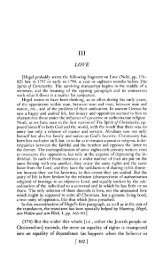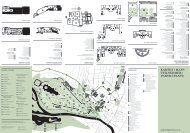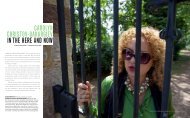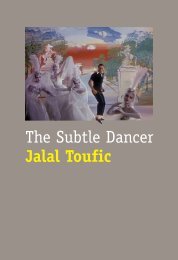Among other things, the manifesto Declaração de Princípios Básicos da Nova Vanguarda, 4 written<strong>and</strong> signed by various artists with the theoretical contribution of Hélio Oiticica, rehabilitated certainaspects of Andrade’s Anthropophagous Manifesto of the Week of 22, 5 since it aimed at the same‘Brazilianisation’: it wanted a strong <strong>and</strong> autonomous Brazilian art. But it is also based on a Neo-Concrete manifesto, 6 written by Ferreira Gullar, that sees a work of art, not as a machine or an object,but as a quasi-body, an organic being. Therefore, it shares with the Neo-Concrete movement aphenomenological approach to the work of art. But undoubtedly our manifesto goes further, since itassumes, proposes <strong>and</strong> exp<strong>and</strong>s art as a revolutionary contribution to all the fields of man’sconscience <strong>and</strong> sensitivity, <strong>and</strong> gives sense to sensorial works <strong>and</strong> to those works that seek audienceparticipation.5): In the 1960s, in Brazil <strong>and</strong> other parts of the world, there was a resurgence in artisticpractices of the body <strong>and</strong> subjectivity that had been absent or repressed in the more abstractpractices. There was also a move towards audience participation.Yes, there is a change of attitude towards art. The manifesto, which, as far as I can remember, wasone of the last spontaneous collective declarations, was created for the exhibition Nova ObjetividadeBrasileira. This exhibition has become a point of reference in Brazilian art because it marked thatchange of attitude. Artists from many different tendencies took part, <strong>and</strong> also artists who wereoriginally Neo-Concrete but who had already begun to move away from Neo-Concrete practices, suchas Lygia Clark, Lygia Pape <strong>and</strong> Hélio Oiticica.6): What was your participation in Nova Objetividade Brasileira?I exhibited a sculpture made of stuffed fabric – a big ear entitled Pssiu!, in reference to the country’sparanoia at the time with telephone tapping, as practiced by the government’s repressive institutions. Ialso exhibited some wood engravings.7): In your wood engravings of the 1960s (ANNA, Glu Glu Glu, Pssiu!, etc.), the themes <strong>and</strong>attitudes that would define your work thereafter are already apparent.Themes that were hidden from me at the time, totally unconscious. I was not yet aware of where mywork was going.8): What were you interested in at the time?My work from the 1960s is motivated by intimate situations <strong>and</strong> experiences, such as women’severyday life. Some critics at the time saw it as prosaic, banal, obvious. It was a socially excludedtheme… it still is. On the other h<strong>and</strong>, military repression was also part of our everyday life, <strong>and</strong> someof my works, such as O Herói (The Hero) <strong>and</strong> Glu Glu Glu, both from 1966, reflect these political <strong>and</strong>social concerns.9): So Glu Glu Glu is already in line with some of your later works, such as Monumento à Fome(Monument to Hunger) <strong>and</strong> Arroz e Feijão (Rice <strong>and</strong> Beans), where you talk about the waywealth is distributed. Does it refer to hunger?Yes. It is a seminal work that gave rise to many others where I try to tackle poverty <strong>and</strong> to subvert thefeelings of impotence <strong>and</strong> guilt that one feels before injustice. It’s the hunger of my childhood, ofBrazil, of the whole world.10): When I look at the relief Glu Glu Glu, or the wood engraving, <strong>and</strong> at the way you relatewhat comes in <strong>and</strong> out of the body, I am reminded of the medieval alchemists who portrayedthemselves as stomachs.
Of course, it is a place for creation. There is an analogy there, because, where do we think? In thestomach? In the soul? In the spirit? Or in the mind?11): For the alchemists, the stomach was a place for vital transformation. The world came inthrough the mouth, things were transformed in the stomach, <strong>and</strong> through defecation the vitalcycle came full circle, since the corruption of an element could regenerate another. Your way oftalking about the body is always related to that transformation <strong>between</strong> the inside <strong>and</strong> theoutside. We could say that all your work is about transformation.Our basic needs are central to us, <strong>and</strong> some are primary psychological needs that are inherent to all ofus. Themes such as hunger, the body, what comes in <strong>and</strong> out of the body, have been approached bymany people. Meanwhile, all works of art originate in the individual experience of the artist, it is theexperience that defines them <strong>and</strong> makes them unique. I would go as far as saying that my works aboutdigestion come from what my mouth remembers of my mother’s breast, the comfort of that first food,while as a counterpoint, I see defecation as the ‘first work’. For, if the body is the architect of work, itis not surprising that in some cultures they refer to defecation as ‘work’. We live <strong>and</strong> die from themouth to the anus. I find it impossible not to talk, not to poetise about what comes in <strong>and</strong> out of thebody, when these are experiences that are fundamental, corporal <strong>and</strong> vital to us.12): This allusion to the abject, already outlined in your earlier works, keeps reappearing inyour work, in a scatological state, or in the installations of unfired clay that can be seen asexcrements or organic parts.This is a paradox, because my work also has a clean aspect, almost elegant, I would say. But if we aretalking about ‘inside <strong>and</strong> outside’, this implies movement, transit, <strong>and</strong> it leads us to vital aspects. Ifyou think about life, you’ll see that nature renews itself in the movements of contaminated transits. Isthere anything more contaminated than the birth of a child? In the south of Italy they refer to luckypeople as being ‘born covered in shit’. Seeds rot before they germinate. Fortunately, nature doesn’t‘do clean’. There is an intrinsic duality in it, without any kind of moralisation. It exists with all itsopposites. Bataille says: ‘I love purity to the extent of loving impurity, without which purity would becounterfeit.’ Luckily, in art, all higher <strong>and</strong> lower aspects of existence are susceptible to appropriation<strong>and</strong> transformation.13): It seems odd that the notion of the abject already appears in your early works. The abjectis, psychologically speaking, related to the construction of subjectivity, since the formation ofsubjectivity is to do with language but also with the abject, which is what has been expelled bythe body <strong>and</strong> turned into an alien element. So the abject establishes the limits of the body –which are maintained by social regulation <strong>and</strong> control – but also those of the subject.Now, more than ever, art owes much to subjectivity, since contemporaneity emphasises the processes,<strong>and</strong> therefore the modes <strong>and</strong> behaviour that, in themselves, affirm subjectivity in a meta-art. In mywork, the discourse of subjectivity has been reinforced by a desire to form myself as a person <strong>and</strong> tointroduce a healing process in the artistic work. Look, you can establish all sorts of analogies with thedigestive system, <strong>and</strong> one of them would be the place of desire. The intestine is a hole that we cannever fill, just as we can never fulfil desire. I think man invented God in order to fill this immense,eternal void that never gets full <strong>and</strong> is never satisfied. Maybe that’s why we make art.14): In your work there’s always been a search for language that you associate with the searchfor identity.Well, my youthful need to find an identity has disappeared. In the end, I understood that identity is adynamic process of formation. When you manage to articulate a language, you can also articulate themultiple aspects of life. What I did learn intuitively is that to form myself as a person, <strong>and</strong> to be ableto be in the world with all its nastiness <strong>and</strong> beauty, also meant to form myself as an artist. I was








